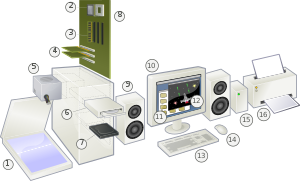Hardware

Computer hardware is a comprehensive term for all physical and tangible parts of a computer, as distinguished from the data it contains or operates on, and the software that provides instructions for the hardware to accomplish tasks. Some sub-systems of a personal computer may contain processors that run a fixed program, or firmware, such as a keyboard controller. Firmware usually is not changed by the end user of the personal computer.
Most 2010s-era computers only require users to plug in the power supply, monitor, and other cables. A typical desktop computer consists of a computer case (or "tower"), a metal chassis that holds the power supply, motherboard, hard disk drive, and often an optical disc drive. Most towers have empty space where users can add additional components. External devices such as a computer monitor or visual display unit, keyboard, and a pointing device (mouse) are usually found in a personal computer.
The motherboard connects all processor, memory and peripheral devices together. The RAM, graphics card and processor are in most cases mounted directly onto the motherboard. The central processing unit (microprocessor chip) plugs into a CPU socket, while the memory modules plug into corresponding memory sockets. Some motherboards have the video display adapter, sound and other peripherals integrated onto the motherboard, while others use expansion slots for graphics cards, network cards, or other I/O devices. The graphics card or sound card may employ a break out box to keep the analog parts away from the electromagnetic radiation inside the computer case. Disk drives, which provide mass storage, are connected to the motherboard with one cable, and to the power supply through another cable. Usually, disk drives are mounted in the same case as the motherboard; expansion chassis are also made for additional disk storage.
For large amounts of data, a tape drive can be used or extra hard disks can be put together in an external case. The keyboard and the mouse are external devices plugged into the computer through connectors on an I/O panel on the back of the computer case. The monitor is also connected to the input/output (I/O) panel, either through an onboard port on the motherboard, or a port on the graphics card. Capabilities of the personal computers hardware can sometimes be extended by the addition of expansion cards connected via an expansion bus. Standard peripheral buses often used for adding expansion cards in personal computers include PCI, PCI Express (PCIe), and AGP (a high-speed PCI bus dedicated to graphics adapters, found in older computers). Most modern personal computers have multiple physical PCI Express expansion slots, with some having PCI slots as well.
A peripheral is "a device connected to a computer to provide communication (such as input and output) or auxiliary functions (such as additional storage)". Peripherals generally connect to the computer through the use of USB ports or inputs located on the I/O panel. USB Flash Drives provide portable storage using flash memory which allows users to access the files stored on the drive on any computer. Memory cards also provide portable storage for users, commonly used on other electronics such as mobile phones and digital cameras, the information stored on these cards can be accessed using a memory card reader to transfer data between devices. Webcams, which are either built into computer hardware or connected via USB are video cameras that records video in real time to either be saved to the computer or streamed somewhere else over the internet. Game controllers can be plugged in via USB and can be used as an input device for video games as an alternative to using keyboard and mouse. Headphones and speakers can be connected via USB or through an auxiliary port (found on I/O panel) and allow users to listen to audio accessed on their computer, however speakers may also require an additional power source to operate. Microphones can be connected through an audio input port on the I/O panel and allow the computer to convert sound into an electrical signal to be used or transmitted by the computer.
Comments
Post a Comment